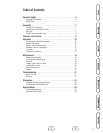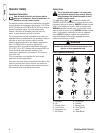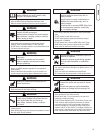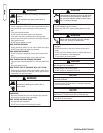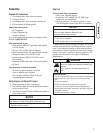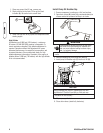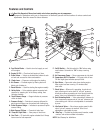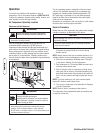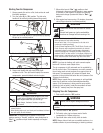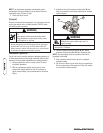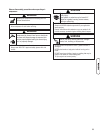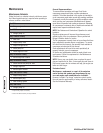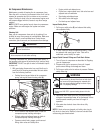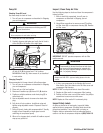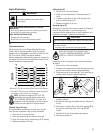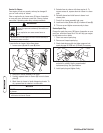
11
Starting Your Air Compressor
1. Always operate this unit on a flat, level surface to avoid
lubrication problems.
2. Turn fuel valve (A) to “On” position. The fuel valve
handle will be vertical (pointing toward the ground).
3. Open start valve (B, shown in open position) by flipping
the pin up to a vertical position.
4. Push on/off switch (C) to “On” position.
5. Move choke lever (D) to “Choke” ( ) position.
6. Grasp recoil handle and pull slowly until slight
resistance is felt. Then pull handle rapidly to overcome
compression, prevent kickback and start engine.
IMPORTANT: If excessive fuel is present in the air/fuel
mixture causing a “flooded” condition, move choke lever to
“Run” ( ) position and pull handle repeatedly until engine
starts.
7. Move choke lever to “Run” ( ) position a short
distance at a time over several seconds in warm weather
or minutes in cold weather. Let engine run smoothly
before each change. Operate with choke in “Run” ( )
position.
8. After engine has been running 1-2 minutes, close start
valve (flip pin down to a horizontal position).
NOTE: If engine fails to start, refer to Troubleshooting.
NOTE: If you hear air leaking, pull quick connect coupler
back until it clicks to reset coupler valve.
The air compressor is fully automatic and is controlled by
the idle control valve. The compressor runs until pressure in
the air tanks reach cut-out pressure, then engine slows to
idle speed. The compressor will resume full speed when
pressure in the air tanks falls below the cut-in pressure. See
Glossary for definitions.
NOTE: Always operate the air compressor in well-ventilated
areas free of gasoline or other flammable/combustible
vapors. If the compressor is being used to spray volatile
chemicals (such as paint), locate the compressor at least
20 feet (6.1 meters) away from the spray area.
Stopping Your Air Compressor
1. Push on/off switch to “Off” position.
2. Turn fuel valve to “Off” position.
3. Pull safety valve ring to release most of tank’s
compressed air. Release valve ring.
4. Open both drain valves to fully drain air tanks.
NOTE: Always drain air tank over a washable surface or in a
suitable container to prevent damaging or staining surfaces.
WARNING
Contact with muffler area can result in serious
burns.
Exhaust heat/gases can ignite combustibles,
structures or damage fuel tank causing a fire.
• DO NOT touch hot parts and AVOID hot exhaust gases.
• Allow equipment to cool before touching.
• Keep at least 5 feet (1.5 m) of clearance on all sides of air
compressor including overhead.
• Code of Federal Regulation (CFR) Title 36 Parks, Forests, and
Public Property require equipment powered by an internal
combustion engine to have a spark arrester, maintained in
effective working order, complying to USDA Forest service
standard 5100-1C or later revision. In the State of California a
spark arrester is required under section 4442 of the California
Public resources code. Other states may have similar laws.
WARNING
Starter cord kickback (rapid retraction) can result
in bodily injury. Kickback will pull hand and arm
toward engine faster than you can let go.
Broken bones, fractures, bruises, or sprains
could result.
• NEVER pull starter cord without first opening start valve to
release pressure.
• When starting engine, pull cord slowly until resistance is felt and
then pull rapidly to avoid kickback.
B
A
C
D
WARNING
Backfire, fire or engine damage could occur.
• DO NOT stop engine by moving choke control to “Choke”
()
position.



